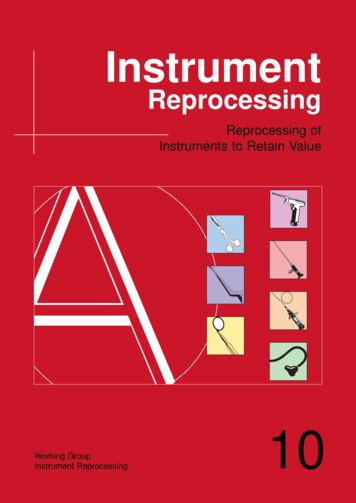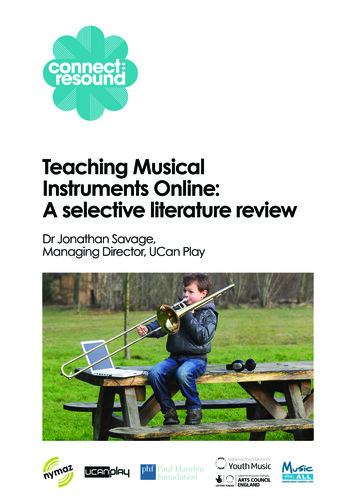
Transcription
APPENDIXMUSICAL INSTRUMENTS & ENSEMBLESMUSICAL INSTRUMENTS OF THE WESTERN WORLDEvery musical instrument or voice has its own characteristic sound. Once you becomefamiliar with these, you will start to hear music "in color."The HUMAN VOICEThough not an "instrument" in the strictest sense—the voice is one of the most colorful vehiclesfor musical expression. It is certainly the most personal of all instruments (each voice isunique)—and the only one capable of presenting both words and musical soundsimultaneously. (Voices can also make many noise-like sounds that are colorful in their ownright). Voices are classified by their tone-color, register and range: soprano (highest female voice) mezzo-soprano (rich female voice mixing soprano and alto colors) contralto or "alto" (lowest female voice) countertenor (a very high male voice) tenor (high male voice) baritone (rich male voice mixing tenor and bass colors) bass (very low male voice)Young boys whose voices have not yet "changed" can sing in the soprano or alto ranges.Boy sopranos have a sweet sound that is much less intense than a female soprano.Instrumental families can also be categorized by the designations soprano, alto, tenor andbass), as described below.143
APPENDIX: Musical Instruments & EnsemblesThe STRING FamilyThe string family is comprised of instruments whose sounding mechanism is directly contactedby the hands. Many stringed instruments are played with a bow, which greatly increases thepossible sounds that the instrument can produce. The most common types of stringedinstruments include: the violin family (violin, viola, violoncello and double bass) the harp the guitar family (guitar, bass guitar, banjo, mandolin, ukulele) various folk instruments such as the dulcimer or the psaltery the ancient viol family (ancestors to the violin family)The violin family became the core of the modern orchestral string section in the mid- 1600s.The standard range categorization of this family is as follows: Violin (soprano), Viola (alto), Cello (tenor), Double Bass (bass)Note: The piano and the harpsichord ARE NOT string instruments, since the player's handsdo not come in direct contact with the strings.ViolinViolaDoubleBassCelloThe Violin Family144
APPENDIX: Musical Instruments & EnsemblesThe WOODWIND FamilyThe woodwind family is comprised of wooden instruments that the player must blow intoto create a musical sound. Most members of the modern woodwind family are "reed"instruments (a piece of wooden reed attached to its mouthpiece adds character to the sound).The complete woodwind family became a standard part of the orchestra by the early 1800s.Common woodwind instruments include: the piccolo (very high) and various-sized flutes the oboe and the "English" Horn (a tenor oboe) various-sized clarinets the bassoon and contrabassoon (very low bassoon) various-sized saxophones various-sized recorders (ancestors to the modern flute family)The standard range categorization of this family is as follows: Flute (soprano), Oboe (alto), Clarinet (tenor) Bassoon (bass)Note: The organ is essentially a wind instrument (when its keys are pressed,compressed air is passed through a series of t)Common Woodwind Instruments145
APPENDIX: Musical Instruments & EnsemblesThe BRASS familyThe brass family is comprised of powerful metallic instruments that must be blown into by theplayer to make a musical sound. The tone-color (timbre) of most brass instruments can bealtered by the use of various types of mutes which are inserted into the large end of theinstrument. Until the invention of the VALVE, brass instruments could only produce a limitednumber of pitches, which lessened their usefulness to composers. Instrument buildersexperimented with various VALVES that would avail more pitch varieties to these instruments.Many modern brass instruments have a system of 3 VALVES that can be depressed in variouscombinations to produce different pitches. The modern "rotary" valve was invented in the earlyRomantic period (c. 1830)—an invention that made the brass family more responsive andreliable. As a result, Romantic composers made greater use of the brass family.The most common types of brass instruments include: various-sized trumpets (use valves to change pitch) various-sized trombones (use a slide instead of valves to change pitch) the "French Horn" (use valves to change pitch) the Tuba—a very low brass instrument (uses valves to change pitch)The standard range categorization of this family is as follows: Trumpet (soprano), Alto Trombone (alto), Tenor Trombone and upper French Horn(tenor), Bass Trombone and low French Horn (bass)valvesbellmouthpiecetuning slidewater key("spit valve")Trumpet (B-flat)Tenor TromboneFlugelhornFrench HornTubaCommon Brass Instruments146Sousaphone
APPENDIX: Musical Instruments & EnsemblesThe PERCUSSION familyThe percussion family is comprised of instruments that must be struck by an object (usually amallet, a stick, or a hammer) in order to produce a musical sound. Composers have madegreater use of percussion color in their scores since the 1880s. Percussion instruments fall intotwo types (pitched and non-pitched):PITCHED Percussion (can play specific notes): timpani (various-sized kettle drums) piano and harpsichord (an internal object hits the strings) orchestra bells ("chimes"), glockenspiel (a rack of metal bars), and handbells xylophone (an arranged series of various-sized metal bars) marimba (an arranged series of various-sized wooden bars) vibraphone ("vibes"—an electric "xylophone" with windpipes)NON-PITCHED Percussion (no distinct pitch is created): bass drum snare drum castanets cymbals triangle tambourine gong (a large, suspended "Chinese" cymbal)Both pitched and non-pitched percussion instruments can be classified by range, for example: Triangle/Glockenspiel (soprano), Snare Drum (alto), Timpani (tenor), Bass Drum (bass)SnareDrumChimes(Tubular Bells)Bass DrumTimpaniTriangleCymbalsXylophoneSome Common Percussion Instruments147
APPENDIX: Musical Instruments & EnsemblesThe PIANOThe piano, the most prominent of all keyboard instruments, is actually a percussion instrument,because it employs an intricate key-mechanism that engages a felt-tipped hammer to attackthe string. The piano can produce a variety of dynamic contrasts and tone colors, depending onhow hard/fast the keys are depressed by the player. The original piano prototype was called a"Fortepiano," because it was capable of playing both loud and quiet (unlike a harpsichord whichhas no dynamic variance.)ELECTRIC and ELECTRONIC InstrumentsVarious ELECTRIC instruments (such as electric guitars, keyboards and amplifiers) haverisen to prominence in the late 20th century, primarily due to developments in popular music.ELECTRIC instruments, however, should not be confused with ELECTRONIC instruments—true synthesizers that rely on digital and/or microchip computer technology. Synthesizedinstruments can simulate traditional musical sounds as well as create sounds that arecompletely original. Many synthesized keyboards, guitars, drum machines and windinstruments can communicate with computers through a technology known as MIDI ("MusicalInstrument Digital Interface"). Synthesizers and the more traditional "Electric" keyboards andguitars have added new dimensions of color to modern music.Electric Guitar (Fender)Digital Synthesizer (Electronic)Electro-magneticpick-upsTremolo barVolume and Tone control knobs148
APPENDIX: Musical Instruments & EnsemblesCOMMON ANCIENT INSTRUMENTSThe VIOL Family (Ancestors to the modern violin family):These bowed instruments come in a variety of sizes, and they have a lighter sound thanthat of the modern violins.The LUTE Family (Ancestors to the modern guitar family):The lute is a pear-shaped guitar-like instrument with a rounded back and a short, widefingerboard. The lute, and its larger relative the chitarrone (Bass-lute) were the mostsophisticated polyphonic string instruments of the Renaissance.Ancient WIND instruments (ancestors to the modern woodwind family).Recorders (the preferred wind instruments of the Renaissance period) are various-sizedwooden instruments that play much like a flute, but are softer in sound. The shawm, thecrumhorn, and the racket are raucous-sounding reed-instruments that are ancestors to themodern oboe and bassoon.Ancient BRASS instruments (ancestors to the modern Brass family).Sackbuts are trombone-like instruments of various sizes used in the Medieval,Renaissance and Baroque eras. The cornetto and the serpent are trumpet-like woodenand leather instruments that use finger holes instead of valves to produce their pitches.The natural horn is a valveless brass instrument that evolved into the modern "Frenchhorn."CrumhornViol' dagambaRecorderShawmLuteSerpentSelected Ancient Instruments149
APPENDIX: Musical Instruments & EnsemblesAncient Keyboard InstrumentsThe harpsichord and organ were the most prominent types of keyboard instruments in theRenaissance and Baroque periods.The HARPSICHORD (an ancestor to the modern piano)The harpsichord's distinctive "plucked" sound isdue to its unique key mechanism: When one ofits keys is pressed, a quill attached to a leverplucks the respective string, producing a sharp,dry sound that dies away quickly.The harpsichord was the most popularkeyboard instrument of the Renaissanceand Baroque periods. It is still used todayby performers specializing in early music.The ORGANThe organ—the most complex Westerninstrument ever devised— is comprised of aseries of wooden or metal pipes connected toone or more keyboards (called manuals) via aset of "stops" (mechanical levers or electricalswitches that open or close air flow to the individual pipes). Before the advent of electricmotors, the wind pressure had to be supplied by an assistant pumping a bellows (acorrugated air bag).This cross-section diagram of an 18th-century French organ, shows the hand-pumpedair bellows and several manuals (keyboards) on the organ's console. A cut-away viewof an interior church wall is located in the center of the diagram (the organist is to theright of the wall, the bellows operator is to the left of the wall).150
APPENDIX: Musical Instruments & EnsemblesMUSICAL ENSEMBLESIt is essential that you remember the difference between an ensemble and a genre.An ensemble (pronounced "ON-SAHM-BULL") is a group of musicians playing together.Ensembles range in size from smaller groups, such as string quartets (four players), tolarger ensembles such as the symphony orchestra. The "type" of piece that a musicianplays (such as symphony, concerto, Mass, motet, etc.) is the genre (pronounced"GSHAN-RUH")—the category of musical composition. For the most part, the terms forgenres and ensembles are easily distinguishable. In a few cases, however, the same termcan be used to describe BOTH a genre AND the ensemble that plays it. For example, thestring quartet is a four-player chamber ensemble BUT it is also a genre. In other words,Beethoven's String Quartet in C minor is performed by an ensemble of four stringplayers, but this work is also an example of the string quartet genre. The term symphonycan also refer to BOTH a genre and the ensemble that plays it. It might be helpful toillustrate this with a musical example from a concert program:The GROVE SYMPHONY ORCHESTRADr. Joseph Twotwaba, ConductorSymphony no. 1 in C minorUn poco sostenuto-AllegroAndante sostenutoUn poco AllegrettoAdagio-Allegro non troppoJohannes Brahms(1833-97)Garden Grove Civic AuditoriumSaturday, November 2, 2007 8 PMYou can probably tell right away that the performing ensemble is a symphonyorchestra. Now, what genre of music is being performed? It is evident by thetitle, Symphony No. 1 in C Minor, that the genre is also a symphony. Eachindividual movement of this four-movement work has its own form (you can tellthere are four movements because there are four Italian tempo indications listedbelow the title of the work).***The following are descriptions of the most common "classical" ensembles:151
APPENDIX: Musical Instruments & EnsemblesENSEMBLES (performing groups)Large EnsemblesOrchestra (also called Symphony or Symphony Orchestra)divided into four main families of instruments: string, woodwind, brass, and percussion.The illustration below shows one possible arrangement in relation to the conductor:EXAMPLES of ORCHESTRAL INSTRUMENTSBRITTEN: Young Person's Guide to the OrchestraSee MUSIC GUIDE 1 (page 8)TimpaniTrumpetsPercussionTrombonesTubaFrench ViolasFlutesFirst ViolinsConductorCellosSecond ViolinsConcert Bandan orchestra without strings, with more emphasis given to the brass, woodwind andpercussion. Types include symphonic band, jazz or dance band, and military band.Choir (or Chorus)a body of singers divided into sections according to voice type. Choirs may be allmale, all female, or mixed (women: soprano & alto / men: tenor & bass).152
APPENDIX: Musical Instruments & EnsemblesSmall EnsemblesBasso Continuoprovided an improvised harmonic accompaniment for many types of Baroque music(similar in function to the keyboard and bass instruments in today's jazz, rock and popstyles). Basso continuo was usually comprised of a keyboard instrument (harpsichordor organ) and a melodic bass instrument (cello or viol' da gamba).HarpsichordViol' da gambaChamber Ensemblesgroups of 1 to 10 players that perform chamber music (usually without a conductor).The string quartet and the woodwind quintet are the most common examples ofmodern chamber ensembles.The String Quartetan instrumental ensemble with four players (two violins, viola and cello):The Woodwind Quintet(a quintet is any chamber ensemble having five players). A woodwind quintet is aspecific group of four woodwind instruments (flute, oboe, clarinet, and bassoon)plus "French" Horn (a brass instrument that blends well with winds).153
APPENDIX: Musical Instruments & EnsemblesTHE ROLE OF THE CONDUCTORThink of what would happen if an orchestra had to perform without its conductor?With no one at the helm, the results could be disastrous. Who would determine the temposor the dynamic levels? Who would cue a player after he/she had not played for severalminutes? What about the rehearsals? Without the conductor, much time would be wasted,and rehearsal time for a large, professional ensemble is extremely expensive. Inefficientrehearsals usually lead to poor performances, which can embarrass the performers andresult in loss of audience interest and financial support. Rehearsals can be especiallycritical for the non-professional conductor, whose players/singers are usually less availablefor rehearsals and less skilled than paid musicians. In such cases, the conductor mustallocate the rehearsal time for maximum efficiency—attacking areas where the ensembleneeds the most polishing.Conductors must be multi-talented. They must thoroughly know the musical score(the notes on the printed page) and its proper interpretation (style considerations). Theyshould fully understand instrumental and vocal production, and they must know theabilities and limitations of the group's players. Aside from these innumerable technicaldemands, today's conductors are also responsible for the well-being of the personnel thatmake up their ensembles. Thus, conductors are often involved in hiring, firing or recruitingplayers; they may intervene in contract negotiations or clear up disputes betweenorchestra members, and they usually serve as the liaison between the musicalorganization and the public.Above all, the conductor's greatest responsibility is to determine the properinterpretation of the music. Maestro Varujan Kojian, former conductor of the SantaBarbara Symphony and the Ballet West, put it this way: "If you ask 110 players aboutinterpreting a piece, then you will get 110 different viewpoints. Variety may be the spice oflife, but when it comes to interpreting a piece of music, it should be left to only oneperson—the conductor."So, do not be fooled into thinking that conductors just stand up in front of anorchestra, looking pretty and flapping their arms to impress the audience. Such gestures,which may at first seem flamboyant or unnecessary, help to convey the conductor'sinterpretation to both the players and the audience. Without the efforts that conductorsmake on and off the stage, today's large-scale performances would be virtually impossible.154
Nov 02, 2007 · Ancient WIND instruments (ancestors to the modern woodwind family). Recorders (the preferred wind instruments of the Renaissance period) are various-sized wooden instruments that play much like a flute, but are softer in sound. The shawm, the crumhorn, and the racket are raucous-sounding re










